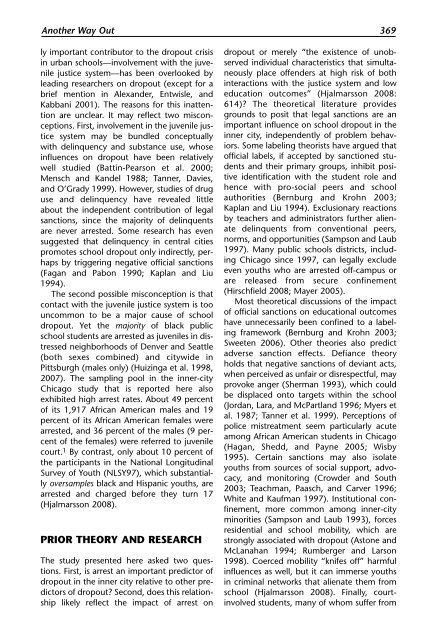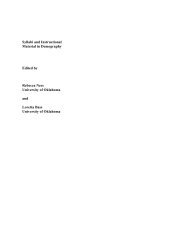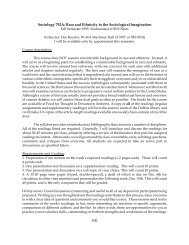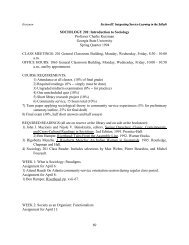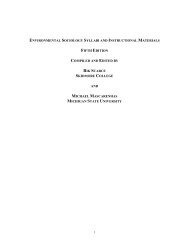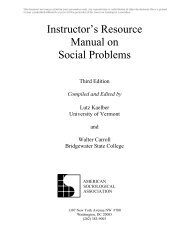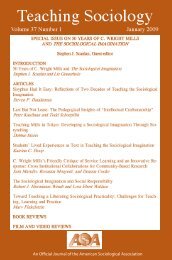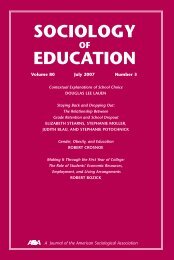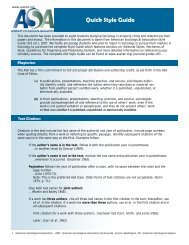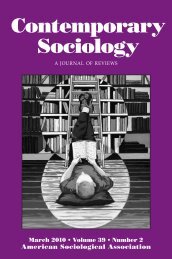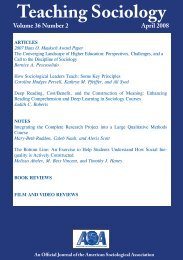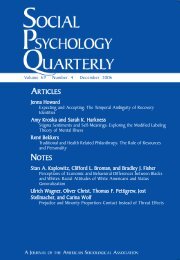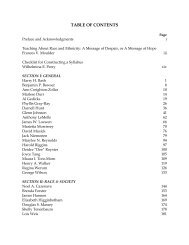SOCIOLOGY EDUCATION - American Sociological Association
SOCIOLOGY EDUCATION - American Sociological Association
SOCIOLOGY EDUCATION - American Sociological Association
Create successful ePaper yourself
Turn your PDF publications into a flip-book with our unique Google optimized e-Paper software.
Another Way Out 369<br />
ly important contributor to the dropout crisis<br />
in urban schools—involvement with the juvenile<br />
justice system—has been overlooked by<br />
leading researchers on dropout (except for a<br />
brief mention in Alexander, Entwisle, and<br />
Kabbani 2001). The reasons for this inattention<br />
are unclear. It may reflect two misconceptions.<br />
First, involvement in the juvenile justice<br />
system may be bundled conceptually<br />
with delinquency and substance use, whose<br />
influences on dropout have been relatively<br />
well studied (Battin-Pearson et al. 2000;<br />
Mensch and Kandel 1988; Tanner, Davies,<br />
and O’Grady 1999). However, studies of drug<br />
use and delinquency have revealed little<br />
about the independent contribution of legal<br />
sanctions, since the majority of delinquents<br />
are never arrested. Some research has even<br />
suggested that delinquency in central cities<br />
promotes school dropout only indirectly, perhaps<br />
by triggering negative official sanctions<br />
(Fagan and Pabon 1990; Kaplan and Liu<br />
1994).<br />
The second possible misconception is that<br />
contact with the juvenile justice system is too<br />
uncommon to be a major cause of school<br />
dropout. Yet the majority of black public<br />
school students are arrested as juveniles in distressed<br />
neighborhoods of Denver and Seattle<br />
(both sexes combined) and citywide in<br />
Pittsburgh (males only) (Huizinga et al. 1998,<br />
2007). The sampling pool in the inner-city<br />
Chicago study that is reported here also<br />
exhibited high arrest rates. About 49 percent<br />
of its 1,917 African <strong>American</strong> males and 19<br />
percent of its African <strong>American</strong> females were<br />
arrested, and 36 percent of the males (9 percent<br />
of the females) were referred to juvenile<br />
court. 1 By contrast, only about 10 percent of<br />
the participants in the National Longitudinal<br />
Survey of Youth (NLSY97), which substantially<br />
oversamples black and Hispanic youths, are<br />
arrested and charged before they turn 17<br />
(Hjalmarsson 2008).<br />
PRIOR THEORY AND RESEARCH<br />
The study presented here asked two questions.<br />
First, is arrest an important predictor of<br />
dropout in the inner city relative to other predictors<br />
of dropout? Second, does this relationship<br />
likely reflect the impact of arrest on<br />
dropout or merely “the existence of unobserved<br />
individual characteristics that simultaneously<br />
place offenders at high risk of both<br />
interactions with the justice system and low<br />
education outcomes” (Hjalmarsson 2008:<br />
614)? The theoretical literature provides<br />
grounds to posit that legal sanctions are an<br />
important influence on school dropout in the<br />
inner city, independently of problem behaviors.<br />
Some labeling theorists have argued that<br />
official labels, if accepted by sanctioned students<br />
and their primary groups, inhibit positive<br />
identification with the student role and<br />
hence with pro-social peers and school<br />
authorities (Bernburg and Krohn 2003;<br />
Kaplan and Liu 1994). Exclusionary reactions<br />
by teachers and administrators further alienate<br />
delinquents from conventional peers,<br />
norms, and opportunities (Sampson and Laub<br />
1997). Many public schools districts, including<br />
Chicago since 1997, can legally exclude<br />
even youths who are arrested off-campus or<br />
are released from secure confinement<br />
(Hirschfield 2008; Mayer 2005).<br />
Most theoretical discussions of the impact<br />
of official sanctions on educational outcomes<br />
have unnecessarily been confined to a labeling<br />
framework (Bernburg and Krohn 2003;<br />
Sweeten 2006). Other theories also predict<br />
adverse sanction effects. Defiance theory<br />
holds that negative sanctions of deviant acts,<br />
when perceived as unfair or disrespectful, may<br />
provoke anger (Sherman 1993), which could<br />
be displaced onto targets within the school<br />
(Jordan, Lara, and McPartland 1996; Myers et<br />
al. 1987; Tanner et al. 1999). Perceptions of<br />
police mistreatment seem particularly acute<br />
among African <strong>American</strong> students in Chicago<br />
(Hagan, Shedd, and Payne 2005; Wisby<br />
1995). Certain sanctions may also isolate<br />
youths from sources of social support, advocacy,<br />
and monitoring (Crowder and South<br />
2003; Teachman, Paasch, and Carver 1996;<br />
White and Kaufman 1997). Institutional confinement,<br />
more common among inner-city<br />
minorities (Sampson and Laub 1993), forces<br />
residential and school mobility, which are<br />
strongly associated with dropout (Astone and<br />
McLanahan 1994; Rumberger and Larson<br />
1998). Coerced mobility “knifes off” harmful<br />
influences as well, but it can immerse youths<br />
in criminal networks that alienate them from<br />
school (Hjalmarsson 2008). Finally, courtinvolved<br />
students, many of whom suffer from


